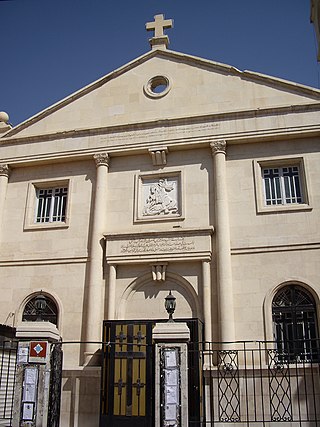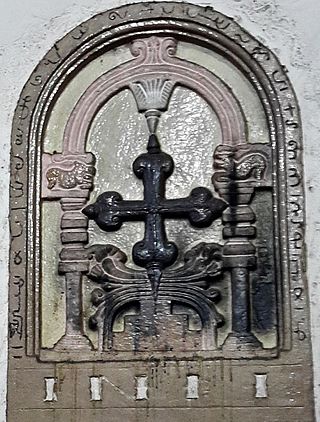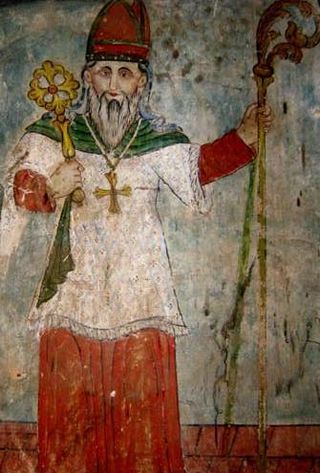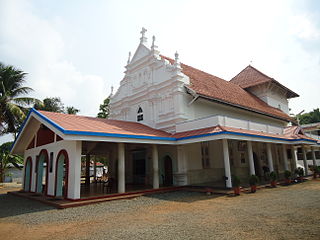
The Malankara Orthodox Syrian Church (MOSC) also known as the Indian Orthodox Church (IOC) or simply as the Malankara Church, is an autocephalous Oriental Orthodox church headquartered in Devalokam, near Kottayam, India. The church serves India's Saint Thomas Christian population. According to tradition, these communities originated in the missions of Thomas the Apostle in the 1st century. It employs the Malankara Rite, an Indian form of the West Syriac liturgical rite.

The Syriac Orthodox Church, officially known as the Syriac Orthodox Patriarchate of Antioch and All the East, and informally as the Jacobite Church, is an Oriental Orthodox church that branched from the Church of Antioch. The bishop of Antioch, known as the patriarch, heads the church, claiming apostolic succession through Saint Peter in the c. 1st century, according to sacred tradition. The church upholds Miaphysite doctrine in Christology, and employs the Divine Liturgy of Saint James, associated with James, the brother of Jesus. Classical Syriac is the official and liturgical language of the church.

Malankara Metropolitan is an ecclesiastical title given to the head of the Malankara Syrian Church, previously by the Government of Travancore and Cochin in South India. This title was awarded by a proclamation from the King of Travancore and the King of Cochin. The Prime jurisdiction regarding the temporal, ecclesiastical and spiritual administration of the Malankara Church is vested in the Malankara Metropolitan. The Malankara Metropolitan is the legal custodian of the Kottayam Old Seminary, interest of vattipanam and Other Common Community properties of Malankara Church.

The Coonan Cross Oath, also known as the Great Oath of Bent Cross, the Leaning Cross Oath or the Oath of the Slanting Cross, taken on 3 January 1653 in Mattancherry, was a public avowal by members of the Saint Thomas Christians of the Malabar region in India, that they would not submit to the Jesuits and Latin Catholic hierarchy, nor accept Portuguese dominance in ecclesiastical and secular life. There are various versions about the wording of oath, one version being that the oath was directed against the Portuguese, another that it was directed against Jesuits, yet another version that it was directed against the authority of Church of Rome

The West Syriac Rite, also called Syro-Antiochian Rite, is an Eastern Christian liturgical rite that employs the Divine Liturgy of Saint James in the West Syriac dialect. It is practised in the Maronite Church, the Syriac Orthodox Church, the Syriac Catholic Church and various Malankara Churches of India. It is one of two main liturgical rites of Syriac Christianity, the other being the East Syriac Rite.

Baselios Thomas I is a Syriac Orthodox Catholicos of India (Maphrian) and head of the Jacobite Syrian Christian Church, the Syriac Orthodox Church in India. He was enthroned on 26 July 2002 by Syriac Orthodox Patriarch Ignatius Zakka I Iwas, Patriarch of Antioch and All the East in a ceremony held in Damascus, Syria.

Mar Thoma I, also known as Valiya Mar Thoma and Arkkadiyokkon Thoma in Malayalam and Thomas de Campo in Portuguese was the first native-born, popularly-selected Metropolitan bishop of the 17th-century Malankara Church. He was the last Archdeacon of the undivided St. Thomas Christians of Malankara (Maliyankara).

The Jacobite Syrian Christian Church (JSCC), or the Malankara Archdiocese of the Syrian Orthodox Church in India also known as Malankara Jacobite Syrian Orthodox Church, the Jacobite Syrian Church, and the Syriac Orthodox Church in India, is a catholicate based in Kerala, India, of the Syriac Orthodox Church of Antioch and part of the Oriental Orthodox Church. It recognizes the Syriac Orthodox Patriarch of Antioch and All the East as supreme head of the church. It functions autonomously within the church, administered by the Metropolitan Trustee, under the authority of the Maphrian of India, Baselios Thomas I. Following schism with the Malankara Orthodox Syrian Church, is currently the only church in Malankara that is directly under a Syriac Christian Antiochian hierarchy, claiming continuity to the 1665 schism. The church employs the West Syriac Rite Liturgy of Saint James.

The Malankara Church, also known as Puthenkur and more popularly as Jacobite Syrians, is the historic unified body of West Syriac Saint Thomas Christian denominations which claim ultimate origins from the missions of Thomas the Apostle. This community, under the leadership of Thoma I, opposed the Padroado Jesuits as well as the Propaganda Carmelites of the Latin Church, following the historical Coonan Cross Oath of 1653. The Malankara Church's modern-day descendants include the Jacobite Syrian Christian Church, the Malankara Orthodox Syrian Church, the Malankara Marthoma Syrian Church, the Malabar Independent Syrian Church, the Syro-Malankara Catholic Church and the Saint Thomas Anglicans of the Church of South India.

Geevarghese Mar Dionysius of Vattasseril popularly known as Vattasseril Thirumeni was a bishop of the Malankara Church, 15th Malankara Metropolitan, and a founder of the Malankara Orthodox Syrian Church. In 2003, the Church declared Mar Dionysius as a saint. He is known as 'The Great Luminary of Malankara Church', a title which the Church bestowed on him in recognition of his contribution to the Church.

St.Paulose Mor Athanasios, popularly known as Aluvayile Valiya Thirumeni, was the Metropolitan of the Angamaly Diocese and malankara Metropolitan of the Malankara Jacobite Syrian Orthodox Church.
The Malankara Rite is the form of the West Syriac liturgical rite practiced by several churches of the Saint Thomas Christian community in Kerala, India. West Syriac liturgy was brought to India by the Syriac Orthodox Bishop of Jerusalem, Gregorios Abdal Jaleel, in 1665; in the following decades the Malankara Rite emerged as the liturgy of the Malankara Church, one of the two churches that evolved from the split in the Saint Thomas Christian community in the 17th century. Today it is practiced by the various churches that descend from the Malankara Church, namely the Malankara Mar Thoma Syrian Church, Malankara Orthodox Syrian Church, the Jacobite Syrian Christian Church, the Syro-Malankara Catholic Church and the Malabar Independent Syrian Church

The Saint Thomas Christian denominations are Christian denominations from Kerala, India, which traditionally trace their ultimate origins to the evangelistic activity of Thomas the Apostle in the 1st century. They are also known as "Nasranis" as well. The Syriac term "Nasrani" is still used by St. Thomas Christians in Kerala.
St. Mary's Church or Marth Maryam Cathedral is a valiyapally of the Syriac Orthodox Church situated in Kothamangalam town in the Ernakulam district of Kerala, India.

St. Mary's Jacobite Syrian Soonoro Cathedral is an ancient Jacobite Syrian church located in Angamaly built in 1564 by Archdeacon Giwargis of Christ, it is one of the most prominent and ancient Syriac Orthodox churches in Kerala. Akapparambu Church is the most ancient church in Angamaly region and this church was a united parish with Akapparambu church for long time. Hence Akapparambu church was called valiyapally and this church was called cheriyapally in olden days. In the seventeenth century it was the residence of Archdeacon Thomas Parambil, who eventually got consecrated as bishop Mar Thoma I. It was the seat of the Archdeacon and later the Malankara Metropolitans, the local heads of the pre-20th century Malankara Church and hence held an important position in the church for several centuries.
Malankara Syriac Knanaya Community are part of the larger Knanaya community who are descendants of an endogamous ethnic migrant group of Syriac-Jewish Christians who arrived and settled in Kerala in the 4th or 8th century.
Syriac Orthodox Patriarchal Delegates of India or the Syriac Orthodox Patriarchal delegate to the India is the representative of the patriarch of the Syriac Orthodox Church, who is sent to India to guide and administer the church, or on special occasions, as the representative of the Holy See of Antioch.

The Holy Qurobo or Holy Qurbono refers to the Eucharist as celebrated in Syro-Antiochene Rite and the liturgical books containing rubrics for its celebration. West Syriac Rite includes various descendants of the Oriental Orthodox and Eastern Catholic churches. It consists of two distinct liturgical traditions: the Maronite Rite, and the Jacobite Rite. The major Anaphora of both the traditions is the Divine Liturgy of Saint James in Syriac language. The Churches are primarily based in the Middle East, Africa, and India.

Saint Thomas Jacobite Syrian church, also known as Paravur Cheriyapally, is a Syrian Orthodox church located in North Paravur, India. This church was constructed in AD 1566 in the midst of the seven bazaars of Paravur town by the parishioners of the ancient Kottakkavu Paravur Valiapally with the monetary aid from the local Tharakan households. The church houses the tomb of famous Syrian Orthodox prelate Gregorios Abdul Jaleel and has staged consecrations of various prelates of the Jacobite Syrian Church since then.

















